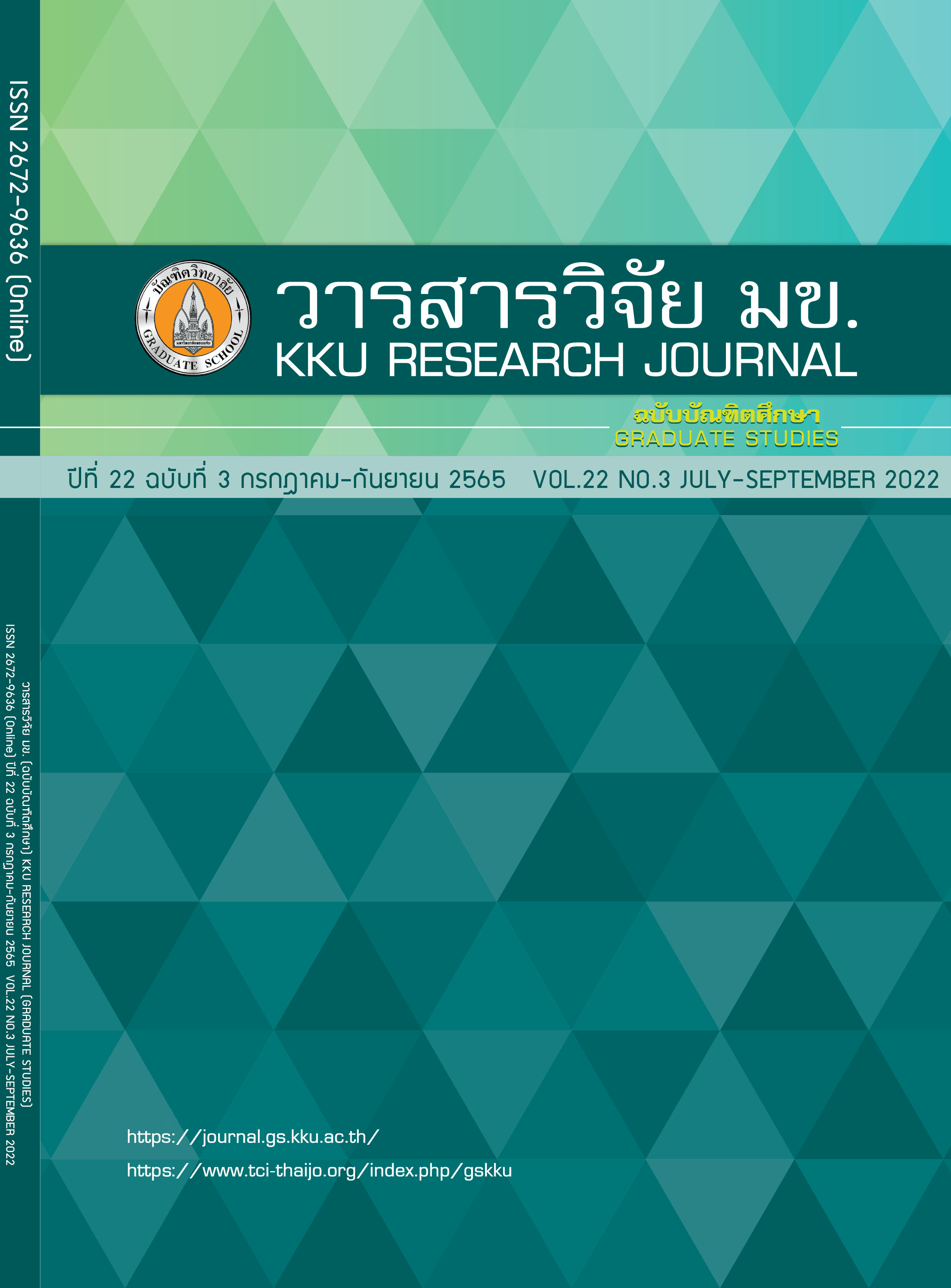The Factors Associated with Fast Food Consumption Frequency Among Health Personnel in Srinagarind Hospital, Khon kean University
Keywords:
Fast food, Health personnelAbstract
A descriptive study aims to determine the proportion of fast-food consumption frequency and factors associated. The sample size was 241. Data collection was online questionnaire. The Cronbach’s alpha was 0.94. The respond rate was 97.5% (235/241). The proportion of fast-food consumption frequency was 38.29 % (95%CI 32.12, 44.87). The factors associated to fast food consumption frequency were exercise (AOR = 0.48 95%CI 0.26, 0.90), working hours (AOR = 2.25 95%CI 1.01, 5.02), cooking (AOR = 0.38 95%CI 0.15, 0.99), buying food (AOR = 3.01 95%CI 1.47, 6.19), and motivation on fast food consumption (AOR = 1.95 95%CI 1.05, 3.62). The organization should launch a physical activity campaign, manage working hours properly, and support healthy menus in cafeteria.
References
De Vogli R, Kouvonen A, Gimeno D. The influence of market deregulation on fast food consumption and body mass index: a cross-national time series analysis. Bull World Health Organ. 2014; 92(2): 99-107A.
Puwastien P, Judprasong K, Sridonpai P, Saiwan T. Fast Foods :Franchise Foods In: David Owens, Anadi Nithithamyong, editors. Thai Composition table. Bangkok: Judthong; 2015. p. 163-171. Thai.
Bureau of Nutrition Department of Health. DIETARY REFERENCE INTAKE FOR THAIS 2020. Bangkok: A.V. PROGRESSIVE; 2020. p. 39. Thai.
Kriengsinyos W. Recommended daily Sodium intake In: Low Sodium Prolong Life. Bangkok: The War Veterans Organization of Thailand Under Royal Patronage of His majesty the King; 2012. p. 4. Thai.
Alsabieh M, Alqahtani M, Altamimi A, Albasha A, Alsulaiman A, Alkhamshi A, et al. Fast food consumption and its associations with heart rate, blood pressure, cognitive function and quality of life. Pilot study. Heliyon. 2019; 5(5): e01566.
Pereira MA, Kartashov AI, Ebbeling CB, Van Horn L, Slattery ML, Jacobs DR, et al. Fast-food habits, weight gain, and insulin resistance (the CARDIA study): 15-year prospective analysis. Lancet. 2005; 365(9453): 36–42.
Xu H, Wu X, Wan Y, Zhang S, Yang R, Wang W, et al. Interaction effects of co-consumption of fast food and sugar-sweetened beverages on psychological symptoms: Evidence from a nationwide survey among Chinese adolescents. J Affect Disord. 2020; 276: 104–111.
Chalermdan N. Consumers’ Behavior on Buying Delivery Food Via Mobile Application During New Species of Corona Virus 2019 (COVID-19) in Bangkok. Journal of Industrial Business Administration. 2020; 2(1): 92–106. Thai.
Al Hazmi T, Alghamdi A, Abdulmajeed I. Eating Habit among Healthcare Providers during Working Hours at National Guard Health Affair-Riyadh, Saudi Arabia. IJMRHS 2018; 7(9): 1-14.
Health Promotion Division. Annual report of health examination among personal in Srinagarind Hospital, faculty of medicine, Khon Kean University in 2563. Khon Kean; 2563.
The proportion of normal body mass index among working age population: 18-59. [internet] [update 2020 Nov 18; cited 2021 Mar 3]. Available from https://dashboard.anamai.moph.go.th/dashboard/ nutri1929fat?year=2020
Abramson JH. WINPEPI updated: computer programs for epidemiologists, and their teaching potential. Epidemiol Perspect Innov. 2011; 8(1):1.
Subphonkulanan L. Type of consumer behavior. In: Thongchua P, Thongchua R, editors. Principle of Marketing: The modern Business Management Lead to successful. Bangkok; stranger book; 2015. p. 58.
Food and Agriculture Organization of the United Nation. Dietary assessment: A resource guide to method selection and application in low resource settings. Rome; 2018.
Podichetty VK, Booher J, Whitfield M, Biscup RS. Assessment of internet use and effects among healthcare professionals: a cross sectional survey. Postgrad Med J. 2006; 82(966): 274–279.
Kunene SH, Taukobong NP. Dietary habits among health professionals working in a district hospital in KwaZulu-Natal, South Africa. Afr J Prim Health Care Fam Med. 2017; 9(1): e1-e5.
Sutidhanakul A. Marketing mix factors affecting the purchasing decision of western fast food in bangkok. [MBA thesis]. Bangkok: Thai-Nichi Institute of Technology; 2560. Thai.
Arunrangsiwed P, Noonkaew R, Kosolkuppong P, Romketphikun T, Kaewprasert P, Plengudomkit K, et al. The Effect of Nutrition Knowledge and Perceived Healthiness on Fast Food Intake. Lampang Rajabhat University Journal. 2020; 7(1): 117–129. Thai.
JB, Reynolds K, Shakib S, Spruijt-Metz D, Sun P, Johnson CA. Acculturation, Physical Activity and Fast-Food Consumption Among Asian-American and Hispanic Adolescents. J Community Health. 2004; 29(6): 467–481.
Anderson B, Rafferty AP, Lyon-Callo S, Fussman C, Imes G. Fast-food consumption and obesity among Michigan adults. Prev Chronic Dis. 2011 Jul;8(4):A71.
Shah T, Purohit G, Nair SP, Patel B, Rawal Y, Shah RM. Assessment of Obesity, Overweight and Its Association with the fast-food Consumption in Medical Students. J Clin Diagn Res. 2014; 8(5): 5–7.
Thornton LE, Jeffery RW, Crawford DA. Barriers to avoiding fast-food consumption in an environment supportive of unhealthy eating. PHN. 2013; 16(12): 2105–2113.
Moore LV, Diez Roux AV, Nettleton JA, Jacobs DR, Franco M. Fast-Food Consumption, Diet Quality, and Neighborhood Exposure to Fast Food: The Multi-Ethnic Study of Atherosclerosis. Am J Epidemiol. 2009; 170(1): 29–36.
Samrong A. Marketing Mix. Psychology of marketing and consumer: Ramkhamhaeng University Press; 2008. p. 5. Thai.
Janphol P. Marketing mix factors and consumption behavior of fast-food consumers at Big C Nakhon pathom supercenter [MBA thesis]. Nakhon Pathom Rajabhat University; 2012. Thai.
Downloads
Published
Issue
Section
License
Copyright (c) 2022 KKU Research Journal (Graduate Studies)

This work is licensed under a Creative Commons Attribution-NonCommercial-NoDerivatives 4.0 International License.



